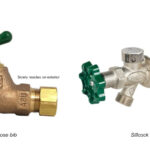Imagine you’re rinsing dishes and, all of a sudden, your kitchen faucet is stuck on spray mode. Frustrating, right?
You’re left with water spraying everywhere, making a simple task a messy ordeal. This common household hiccup can disrupt your daily routine and leave you feeling helpless in your own kitchen. But don’t worry! You’ve landed in the right place to find a solution.
You’ll discover easy steps to fix your faucet, saving you time and preventing future headaches. So, stick around to get your kitchen back in order and make sure that spray mode behaves itself!

Credit: www.reddit.com
Common Causes Of Stuck Spray Mode
Kitchen faucets are essential fixtures, but they can sometimes be frustrating when they get stuck in spray mode. Understanding the common causes can save you time and effort. Have you ever been in the middle of rinsing dishes when suddenly, your faucet refuses to switch back to a stream? Let’s dive into what might be going wrong.
1. Blocked Diverter Valve
The diverter valve is responsible for switching the water flow between spray and stream. If debris or mineral build-up occurs, it can clog the valve, preventing it from functioning properly. Regular cleaning helps maintain its performance.
2. Worn-out Spray Head
Over time, the spray head can wear down, causing it to stick. A worn-out spray head may fail to retract or switch modes smoothly. Consider inspecting it for signs of wear or damage.
3. Faulty Button Mechanism
The button mechanism on your spray head can malfunction due to frequent use or age. If the button feels stuck or unresponsive, it might be time to replace it. A simple check can confirm if it’s the culprit.
4. Low Water Pressure
Low water pressure can disrupt the normal functioning of your faucet. When pressure is insufficient, the spray mode might get stuck. Check your water pressure and ensure it’s adequate for all your fixtures.
5. Incorrect Installation
Incorrect installation can lead to operational issues. If the faucet components aren’t aligned properly, it can cause the spray mode to jam. Review the installation instructions or consult a professional if needed.
Have you checked all these areas, yet still face the issue? Sometimes, the problem might not be as straightforward. Could there be another underlying issue? Regular maintenance and timely replacements can prevent these common causes from turning into bigger problems.

Credit: www.tiktok.com
Tools Needed For Repair
Repairing a kitchen faucet stuck on spray mode can be straightforward with the right tools. Knowing the necessary tools ensures a smooth repair process. This section will guide you through the essential tools needed for the task. With the correct equipment, you can fix the issue efficiently and get back to your daily routine.
Adjustable Wrench
An adjustable wrench is crucial for loosening and tightening nuts. It helps in removing the faucet head. This tool adjusts to various sizes, making it versatile. Ensure you have one in your toolbox.
Phillips Screwdriver
A Phillips screwdriver is essential for unscrewing parts. Many faucets have screws that hold components together. This tool helps in accessing the internal parts. Choose a size that fits the screws perfectly.
Needle-nose Pliers
Needle-nose pliers are useful for gripping small parts. They assist in removing washers and O-rings. Their pointed tips make them ideal for reaching tight spaces. Keep a pair handy during the repair.
Pipe Tape
Pipe tape prevents leaks after reassembly. It seals threaded connections securely. Apply it to threads before connecting parts. This ensures no water escapes from the joints.
Bucket
A bucket is necessary for collecting water. It helps avoid water spills when disassembling the faucet. Place it under the sink during the repair process. It keeps your workspace dry and clean.
Cleaning Cloth
A cleaning cloth is useful for wiping surfaces. It removes dirt and grime from parts. Clean components before reassembling them. This ensures the faucet functions well after repair.
Step-by-step Troubleshooting
Having your kitchen faucet stuck on spray mode can be frustrating. But with a few simple steps, you can troubleshoot this issue. Following a clear process can help you identify the problem and fix it quickly. Let’s delve into each step for a smooth repair experience.
Inspect The Spray Head
First, examine the spray head for visible blockages. Debris can clog the spray head, causing it to malfunction. Carefully unscrew it and check the nozzle openings. Clean them with a soft brush or cloth. Ensure water flows freely through the spray holes. Reattach the spray head and test the faucet.
Check The Diverter Valve
The diverter valve directs water between the spout and spray head. A faulty diverter can keep the faucet in spray mode. Locate the valve inside the faucet body. Remove any sediment buildup that might be affecting its function. Consider replacing it if cleaning doesn’t help. This can often solve the issue.
Examine The Hose And Connections
Inspect the hose connecting the spray head to the faucet. Look for kinks or twists that might restrict water flow. Ensure all connections are tight and secure. Loose connections can lead to pressure issues, affecting spray mode. Tighten any loose fittings and test the faucet again. This might restore normal operation.
Cleaning Techniques
Kitchen faucets often get stuck on spray mode due to mineral buildup. Gently clean the nozzle with vinegar. This can help remove deposits and restore normal water flow.
When your kitchen faucet gets stuck on spray mode, it can be quite frustrating. Cleaning techniques are essential to restore the faucet’s normal function without calling a plumber. Let’s explore some practical cleaning methods that can help you fix this issue efficiently.Removing Mineral Deposits
Mineral deposits are often the culprits behind a stuck spray mode. Hard water leaves behind these deposits, which can clog your faucet’s components. To tackle this, begin by removing the spray head. Check for any visible buildup around the nozzle and the aerator. A small brush or an old toothbrush can be handy for scrubbing away these deposits. Have you ever noticed how a little bit of elbow grease can make a big difference? Consistent cleaning can prevent larger problems down the line.Using Vinegar Solution
Vinegar is a powerful ally in your cleaning arsenal. It’s not just for salad dressing; it works wonders on mineral deposits too. Prepare a vinegar solution by mixing equal parts of white vinegar and water. Submerge the spray head in this solution and let it soak for about 30 minutes. Have you ever thought about why vinegar is so effective? Its acidity breaks down the minerals, making them easier to clean away. After soaking, rinse the spray head thoroughly with water. Reattach it and test if the spray mode is functioning correctly. Regular maintenance using vinegar can keep your faucet in top shape. So, next time you face a stuck spray mode, you know exactly what to do. Have you tried these techniques before? Share your experiences and let us know how they worked for you. Keeping your kitchen faucet clean not only ensures its functionality but also extends its lifespan. Don’t let a stuck spray mode dampen your kitchen chores!Replacing Faulty Parts
If your kitchen faucet is stuck on spray mode, it might be due to faulty parts. Replacing these parts can restore normal function. This task might seem daunting but is manageable with guidance. By following the steps below, you can fix the issue without professional help.
Identifying Replacement Parts
First, identify which parts need replacement. Check the spray head and diverter valve. These are common culprits when a faucet sticks. Check for visible damage or wear. If unsure, consult the faucet manual. This will list part names and numbers.
Match the parts to the model of your faucet. This ensures compatibility. Many brands offer specific replacement kits. These kits simplify the process. Obtain the correct parts before starting the repair.
Installation Process
Begin by turning off the water supply. This prevents leaks during installation. Remove the faulty spray head carefully. Use a wrench if needed. Follow the manual’s instructions for removing parts.
Next, install the new spray head or diverter valve. Ensure each part fits snugly. Tighten connections securely to avoid future leaks. Turn the water supply back on. Test the faucet to ensure spray and stream modes work.
If problems persist, recheck each installation step. Sometimes, a loose connection can cause issues. Tightening all parts might solve the problem. Always keep the manual handy for troubleshooting.
Preventing Future Issues
Facing a kitchen faucet stuck on spray mode can disrupt daily routines. Regular maintenance and gentle cleaning prevent future issues. Ensure smooth operation by checking for mineral buildup or faulty parts, keeping your faucet in top condition.
Preventing future issues with your kitchen faucet stuck on spray mode is not just about fixing the problem but ensuring it doesn’t happen again. Imagine the frustration of dealing with a stubborn faucet right in the middle of meal prep. You don’t want to relive that scenario. By focusing on regular maintenance and choosing durable faucets, you can avoid these headaches and enjoy a smooth kitchen experience.Regular Maintenance Tips
Regular maintenance is key to keeping your faucet in top shape. Start by cleaning the faucet head every month. Mineral deposits can build up, causing the spray mode to malfunction. Use a vinegar solution to dissolve these deposits. Simply soak the faucet head in a mixture of vinegar and water for an hour. This is a simple task that can save you from major issues later. Check the hose and connections for leaks. Loose or damaged parts can lead to spray mode problems. Tightening connections and replacing worn-out hoses can make a big difference.Choosing Durable Faucets
Investing in a durable faucet is a smart move. Look for faucets made from high-quality materials like stainless steel or brass. These materials are less prone to wear and tear. Pay attention to the brand’s reputation. Brands known for durability and reliability often have fewer issues. Research customer reviews and expert opinions before making a decision. Consider the design and functionality. A faucet with a simple mechanism is less likely to get stuck. Modern faucets with advanced features can be appealing, but simplicity often means fewer problems. Have you ever wondered why some faucets last longer than others? It often comes down to the choice of materials and regular care. Make the right choices now to prevent future frustrations in your kitchen.
Credit: www.reddit.com
Frequently Asked Questions
How Do I Fix A Faucet Stuck On Spray Mode?
Check for debris in the spray head. Clean or replace it if needed.
Why Does My Kitchen Faucet Spray Get Stuck?
Mineral buildup or debris can cause the spray mode to stick. Regular cleaning helps.
Can I Replace The Spray Head Myself?
Yes, it’s simple. Unscrew the old one. Attach the new spray head.
What Tools Are Needed For Fixing A Stuck Spray Mode?
A wrench and screwdriver are usually enough. Check your faucet’s manual for specifics.
Is It Expensive To Repair A Stuck Kitchen Faucet?
No, it’s often affordable. Replacement parts and basic tools are usually inexpensive.
Conclusion
Fixing a kitchen faucet stuck on spray mode is manageable. Follow the simple steps outlined. Identify the issue, then apply the right solution. Regular maintenance prevents future problems. A functional faucet enhances your kitchen experience. Remember to check your faucet regularly.
This ensures smooth operation and longevity. Don’t let a small issue cause big inconvenience. Address faucet problems promptly. Enjoy a hassle-free kitchen environment. Keep your kitchen running smoothly. With these tips, you’re well-equipped to tackle faucet issues. Feel confident in maintaining your kitchen fixtures.
Stay proactive, and keep your kitchen efficient.




